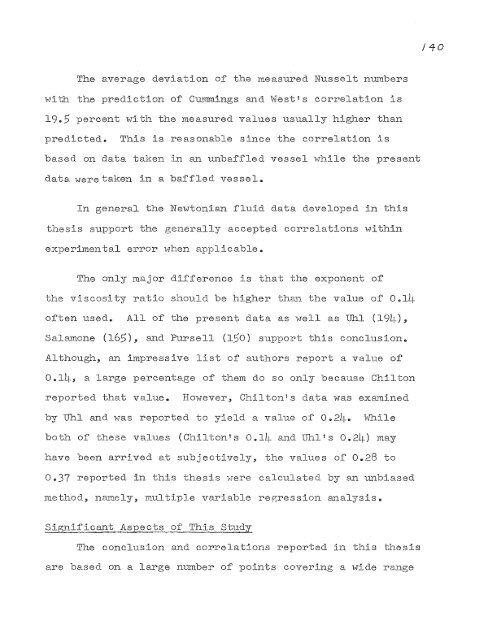Prediction of batch heat transfer coefficients for pseudoplastic fluids ...
Prediction of batch heat transfer coefficients for pseudoplastic fluids ... Prediction of batch heat transfer coefficients for pseudoplastic fluids ...
140 The average deviation of the measured l\fusselt numbers Hi ~h the prediction of Cu..rrrmings and \e1est I s correlation is 19.5 percent 1'-1i th the measured values usually higher than predicted. This is reasonable since the correlation is based on data taken in an 1L.~baffled vessel '\
11-1 of variables. A total of 616 data points were taken, 163 of which were used for screening the variables to be studied and evaluating the effect of impeller height. The remaining 453 data points were used to evaluate the constants of the correlations presented in the previous chapter.. Eleven different impellers representing the fOl.ll'" major types in common practice 1..Jere used in collecting the 4.53 points. The range of application is wide since pseudoplastic as Hell as Newtonian fluids 1,rere used. The use of multiple-variable regression analysis Has a valuable tool in reducing hcunan error and subjectiveness in the calculation of the correlation constants. The measurement of the wall temperature at three different locations gave evidence of the considerable difference in heat flux in diff'erent positions in the vessel. Although the ef'fect was not quantitatively studied it is the f'irst tLme it has been reported; and this opens the door to a possibly fruitful field of' study. It has been shown that the variations in local heat transfer rates can be minimized by proper location of' the impeller. The vertical position of' the impeller Has shown to have a large ef'fect on the Nusselt number in the range studied, ie. f'or impeller height/liquid heie~t ratios be-
- Page 101 and 102: 89 shea.r ra.tes, tl?1ey a.re unaff
- Page 103: and if' lO"V'l$' a sm.all amount of
- Page 106 and 107: 94- was about 40-45 ndmutes .. Tke
- Page 108 and 109: 96 vThere N is in rev./sec .. and S
- Page 110 and 111: 88 ql\fETI A = 6 T \--T -s L/kw (1+
- Page 112 and 113: I {)D The generalized Reynolds n~mb
- Page 114 and 115: 02. CHAPTER !2. RESUI,TS Many heat
- Page 116 and 117: 01 TABLE 5-2 sutn~U{Y OF ADDITIONAL
- Page 118 and 119: 108 the batch than the other ticJO
- Page 120 and 121: 108 optimum impeller heights were u
- Page 122 and 123: 10 I r "'" , •• ,'., "",' """",
- Page 124 and 125: 112 correlations for the prediction
- Page 126 and 127: TABLE 5 - 4 Correlation Constants A
- Page 128 and 129: 1/6 Table 5-5 and 5-6. A measure of
- Page 130 and 131: TABLE S - 6 IMPELLER Correlation Co
- Page 132 and 133: 120 greater than 2.0. In this case
- Page 134 and 135: 12.2
- Page 136 and 137: TABLE 5 - 9 CORRELATION E t (a/n +1
- Page 138 and 139: TABLE 5 - 10 IMPELLER Correlation C
- Page 140 and 141: TABLE 5 - 11 CORRELATION G (1.30/61
- Page 142 and 143: 1.30 of the substantial improvement
- Page 144 and 145: 1.3 2. The probable error in the ca
- Page 146 and 147: 134 .,;' : :: :::: : ~ !~. , " . .'
- Page 148 and 149: T." ••••••• ,_ .....
- Page 150 and 151: 38 the cooling of nitration liquors
- Page 154 and 155: 42 tween 0.25 and 0.58. L~~l had re
- Page 156 and 157: 144 transfer coefficients to non-Ne
- Page 158 and 159: 16 of fit and it may t...herefore b
- Page 160 and 161: 148 'tvas insufficient data to eval
- Page 162 and 163: 50 A ::: Apr ... B ::: C p ::: CPr
- Page 164 and 165: 52. Q ::. Average heat transfer rat
- Page 166 and 167: Xc = Function of Reynolds nL:l.m.be
- Page 168 and 169: IS6 G REE:>{ ALPHABET 0 ::: Value o
- Page 170 and 171: 158 coefficient. Thus, for the wate
- Page 172 and 173: 160 , ., I .. : I :. '. • • !.
- Page 174 and 175: 162 I , . I . "I '1 I i I 1 I 1· '
- Page 176 and 177: 64 ncr --~iIluto e torque of the in
- Page 178 and 179: 166 rive different temperatures; ab
- Page 180 and 181: 168 TABLE A-4. SLOPE OF "LOG SHEAR
- Page 182 and 183: TABLE 11.-5 RHEOLOGICAL DATA FOR CA
- Page 184 and 185: TABLE A-5 (eollt. ) /12 o . 24;;& C
- Page 186 and 187: '11 The flow behavior index and flu
- Page 188 and 189: i .f.C ·F s o 6 1 6 I
- Page 190 and 191: · . . . " , · . :::11" ': "'" ~ .
- Page 192 and 193: 180 Tke thermal e€l1'!ciluetlvity
- Page 194 and 195: 182 Heat capacity data for 100% gly
- Page 196 and 197: IB4- wkiek ex~resses the aensity e
- Page 198 and 199: 186 Ts - Torque X :: Peree~t 0~ ful
- Page 200 and 201: Phase I Calcu13tiJ~ of Slope of !oG
140<br />
The average deviation <strong>of</strong> the measured l\fusselt numbers<br />
Hi ~h<br />
the prediction <strong>of</strong> Cu..rrrmings and \e1est I s correlation is<br />
19.5 percent 1'-1i th the measured values usually higher than<br />
predicted. This is reasonable since the correlation is<br />
based on data taken in an 1L.~baffled<br />
vessel '\



